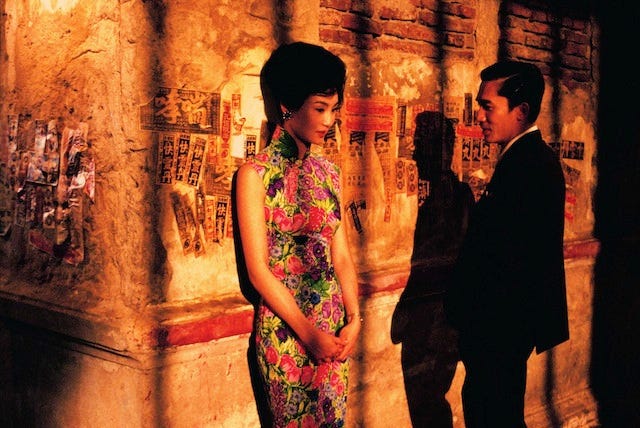The Secret is in Red: How Color Plays a Vital Role in Wong Kar-Wai’s ‘In the Mood For Love’

Wong Kar-Wai’s In the Mood for Love has been considered, for many years, as one of the most romantic movies of all-time. Reading the synopsis, it’s easy to think why: two people who live in the same apartment building find out that their spouses are cheating on them with each other, bringing the two neighbors closer together in a shared betrayal. Fair enough — it’s usually the stuff love stories are made of, anyway. But the film isn’t your run-of-the-mill tale of falling in love with the shoulder you cry on. In fact, it’s not even the script itself that sets it apart from the rest, it’s how the filmmaker chooses to tell it to us. Wong Kar-Wai plays with space, sound, frame composition, lighting and, most importantly, color, to not only show us how a heart breaks, but to make us feel it, too. For such a somber film, it’s surprisingly vivid in color, that seeing the characters grieving over their marriage in such saturated hues creates an emotional dissonance to the viewer where we know this is supposed to feel hollow, it’s supposed to hurt, and yet, the earthy tones and the warm lights give us a semblance of comfort.
As a visual piece, color plays a very significant role in the story because we learn so much more through them than what the dialogue tells us or how the actors portray the characters when they give each other glances, when they smile, when they cry, etc. For instance, despite the dull wallpapers of their apartment hallway or the drabness of the walls of an office or whatever room a scene is taking place in, there always has to be a splash of color. Whether it’s a piece of prop lighting like a desk lamp glowing a bright orange in just one specific part of the room or a vase of yellow flowers on the table or even the characters’ costumes themselves, every piece of prop must draw attention to itself, like it’s pulling you into the film. It makes it more immersive and experiential rather than passively telling you what it’s about.
Every choice about color in this film appear to be deliberate. Particularly, the usage of the color red. Red traditionally symbolizes love or hatred or any other passionate emotion. Here, it is not that much different as its role becomes that of sensuality and temptation. In the Mood for Love is sexy beyond convention as we never actually see sex or kissing or any other intimate action. The abundance of the color red, however, makes it look so sensual and seductive that even when we’re shown the innocence of Mr. Chow and Mrs. Chan’s relationship, we still get that feeling that it’s more than a friendship, and possibly even more than lust. It’s a companionship stemming from a deep loneliness, a void that their respective marriages failed to fill.
The color red is also cleverly used almost like a third character in Mr. Chow and Mrs. Chan’s relationship, present wherever our two protagonists are. Like a voyeur, it acts as the only person who knows their secret and, in effect, their spouses’ secret with how it always has to distinctly appear in a scene with Mr. Chow and Mrs. Chan. Some examples are the red blankets on Mrs. Chan’s bed (the most intimate piece of furniture you could own), her red coat, red chopsticks, red tie, red bag, red taxi cab, and so on. If it’s not in the props or the costumes that the characters directly interact with, it’s usually in the set, like the red curtains in the hotel room
where Mr. Chow and Mrs. Chan rendezvous to write their serials or the distinct red stripe lining the wall on the street that they always pass by on their way home, which was also the place where they first reenacted their spouses infidelity.
Red is also a color that expresses what the characters stubbornly refuse to show, that is, the feelings that they’ve harbored for each other. It draws proper attention to itself when Mr. Chow first invited Mrs. Chan to the hotel room so they don’t have to be so cautious when they’re in the apartment. There, she is wearing a bright red coat that maybe not-so coincidentally matches the curtains outside of Mr. Chow’s hotel room. The curtains hang there mockingly, watching from when Mrs. Chan enters the room to when she leaves. Later, we see the curtains again when Mrs. Chan goes to the same room in hopes of catching Mr. Chow before he leaves the country but dejectedly walks away when she realizes she’s too late. Only this time, the curtains aren’t just there; they finally move, the wind allowing them to take a life of their own, its flowing red fabric like long, delicate fingers reaching into the rooms as if to pull them into temptation and swallow them whole. All the while, we know that our protagonists have given in to their feelings. We won’t be like them, turns into we have become the very thing that has first led us to each other.
There’s so much more to this film than what meets the eye; it’s certainly not just color, but each element working together in perfect harmony to create a piece that not only stimulates the senses but also the emotions by not just feeding them to us. It gives us time to feel every aspect of the film all at once, allowing us to pay attention to its intricate details which are more than just parts of a greater whole: it is an entire story in itself.
